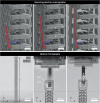Anomalous frozen evanescent phonons
- PMID: 39448565
- PMCID: PMC11502830
- DOI: 10.1038/s41467-024-52956-5
Anomalous frozen evanescent phonons
Abstract
Evanescent Bloch waves are eigensolutions of spatially periodic problems for complex-valued wavenumbers at finite frequencies, corresponding to solutions that oscillate in time and space and that exponentially decay in space. Such evanescent waves are ubiquitous in optics, plasmonics, elasticity, and acoustics. In the limit of zero frequency, the wave "freezes" in time. We introduce frozen evanescent waves as the eigensolutions of the Bloch periodic problem at zero eigenfrequency. Elastic waves, i.e., phonons, in metamaterials serve as an example. We show that, in the complex plane, the Cauchy-Riemann equations for analytical functions connect the minima of the phonon band structure to frozen evanescent phonons. Their exponential decay length becomes unusually large if a minimum in the band structure tends to zero and thereby approaches a soft mode. This connection between unusual static and dynamic behaviors allows to engineer large characteristic decay lengths in static elasticity. For finite-size samples, the static solutions for given boundary conditions are linear combinations of frozen evanescent phonons, leading to interference effects. Theory and experiment are in excellent agreement. Anomalous behavior includes the violation of Saint Venant's principle, which means that large decay-length frozen evanescent phonons can potentially be applied in terms of remote mechanical sensing.
© 2024. The Author(s).
Conflict of interest statement
The authors declare no competing interests.
Figures






References
-
- Joannopoulos, J. D., Villeneuve, P. R. & Fan, S. Photonic crystals. Solid State Commun.102, 165 (1997).
-
- Cummer, S. A., Christensen, J. & Alù, A. Controlling sound with acoustic metamaterials. Nat. Rev. Mater.1, 1 (2016).
-
- Bertoldi, K., Vitelli, V., Christensen, J. & van Hecke, M. Flexible mechanical metamaterials. Nat. Rev. Mater.2, 1 (2017).
-
- Kadic, M., Milton, G. W., van Hecke, M. & Wegener, M. 3D metamaterials. Nat. Rev. Phys.1, 198 (2019).
-
- Brillouin, L. Wave Propagation in Periodic Structures (Dover publications, New York, 1953).
Grants and funding
LinkOut - more resources
Full Text Sources

